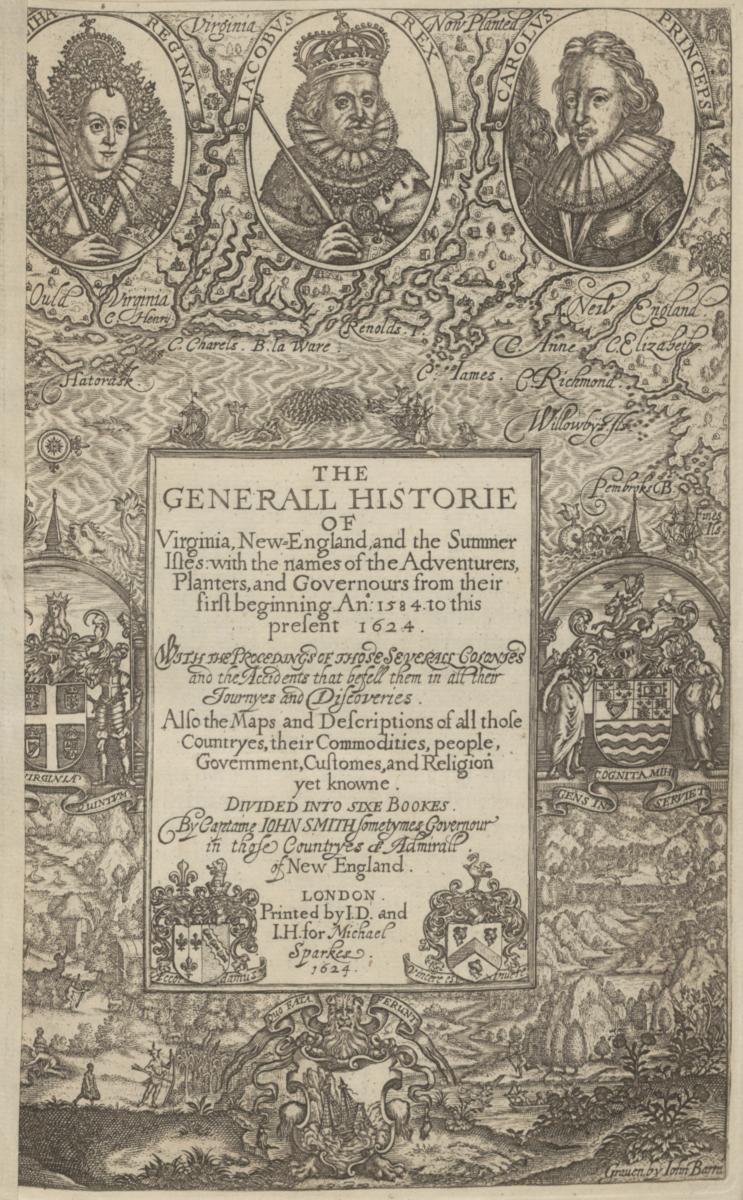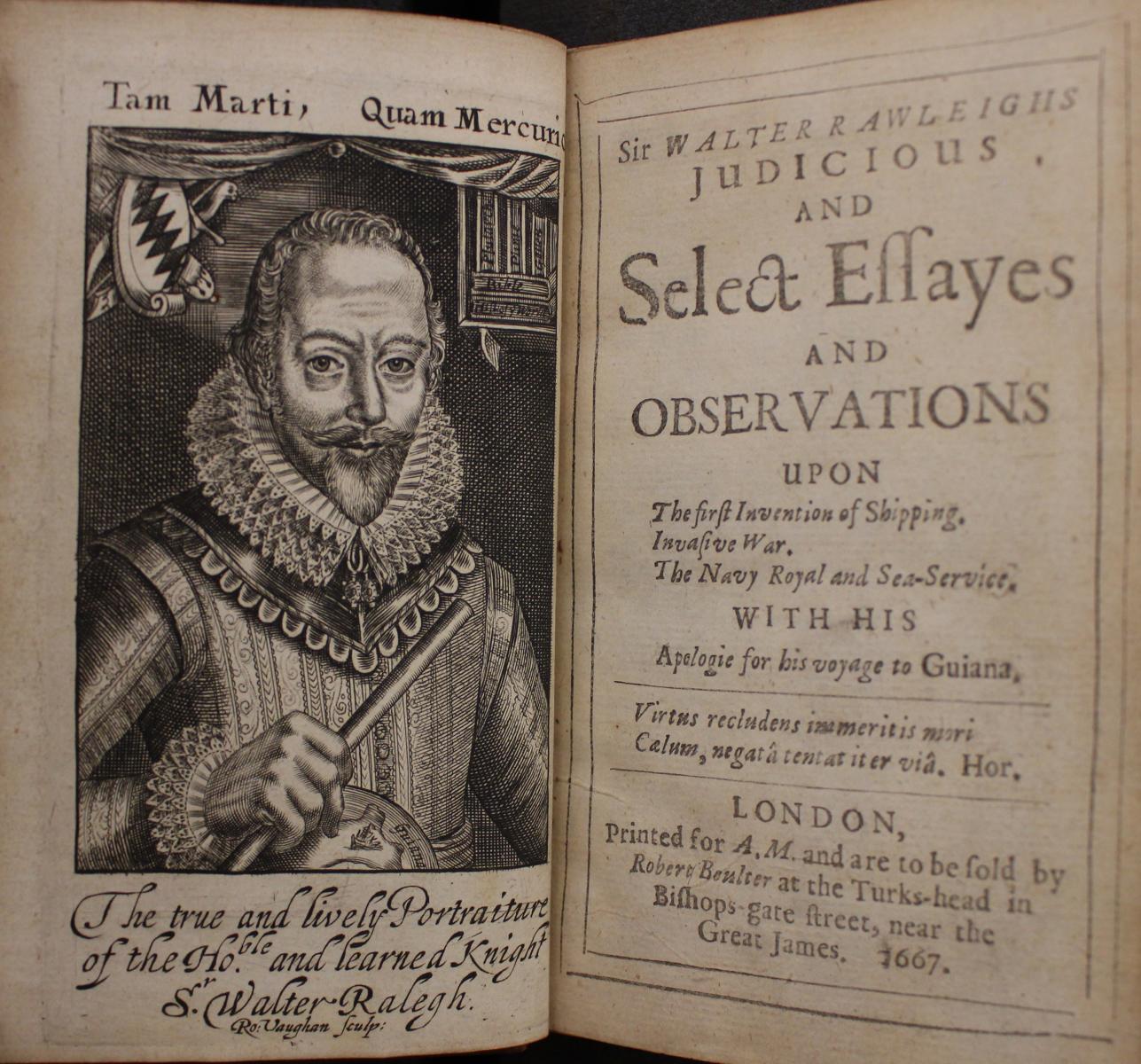Traveling the World
The Age of Exploration began in the 1490s with Portugal and Spain exploring Africa and the Americas, with the resultant exposure in the Americas to diseases, animals, and plants not seen before meaning the landscape was reshaped, and most of the native population being killed. In Africa, slavery was highly destructive, as was opium in East Asia. Colonies were established around the globe, that lasted into the eighteenth and twentieth centuries, with the Age of Revolutions leading to Haiti and America breaking free, and the aftermath of World War II ending the remaining colonial empires. These books deal with English colonization.

John Smith (1580-1631)
The General History of Virginia, New-England, and the Summer Isles…
London, Printed by I. D. and I. H. for Michael Sparkes, 1624
Description: This book is a history and natural history of the English colonies in Virginia, New England and Bermuda. It offers a rich, early primary source of information on Native Americans of the eastern coast of North America and the life of the colonists, organized chronologically, one year after another, and divided into six Books. John Smith was an early English adventurer who became the leader of the Virginia colony. He seems to have been very experienced, but also a self-promoter, and not all of his adventures should be presumed true. He is particularly famous for his affair with the Indian princess Pocahontas. The book is about 11” x 7” in size, about 3/4” thick, and red. The backing and the two outer corners are red, perhaps of leather, while the rest of the outside cover is a darker red with black meanders, perhaps cardboard. There are five cross-ridges on the spine. Inside the front cover and first page is an inner backing of decorative paper, blue with bubbly meanders of purple, pink, yellow, black and white. At the upper left inside the cover is a squarish sticker with an “EX LIBRIS” notice, showing that the book belonged to Charles N. Dietz. This is a black-and-white drawing showing a house made of books called “Temple of Knowledge”, with a bottle of ink on the lower left and a name that seems to be “Hogeboon” on the lower right. Front and back, the text pages are separated from the covers by two blank pages. The pages on all three loose sides are gold edged. On the back page are some sellers’ notes: “$ Sc.nka/90.00 art” and “The First Edition, 1624, of this excessively rare work, with the title and maps in facsimile”. Pages are numbered at the top outside corner. At the top is a page summary noun phrase in italics. The work is divided into six books, and for each, at the top inside corner is the notation of this as, e.g., “Lib. 6.” for Book 6. In the wide margins are short notes to find items in the text. The text is aligned at both margins, and hyphenated when necessary. The paragraphs are indented about two or three spaces, and there is no spacing betwen them. At the bottom right is the first word of the next page. The margins are about 1 1/4” wide. The letter S in both the s form and the tall thing that looks like an f without the cross. The letter v is often written as u, and u as v. Proper names in the text are written in italics. Sections are broken out with italicized titles. The first letter in a section is enlarged to be about three lines high. The book has inset folded maps and drawings. Oddly, there is a break between the third book, which ends on page 96, and the fourth book, which begins on page 105. This is just a numbering break, not a matter of missing pages. There is a title page in front, followed by a dedication, a preface, and then a detailed table of contents. The text quotes many short rhyming couplets, seemingly as proverbs. -- Rory Larson
Adoption Price: $750
ADOPTED!

Sir Walter Raleigh (1552?-1618)
Apology for his Voyage to Guiana: discourse of the invention of ships, anchors, compass, &c. Sir Walter Raleigh's judicious and select essays and observations upon the first invention of shipping, invasive war, the navy royal and sea-service; with his apology for his voyage to Guiana.
London, printed for A. M. and are to be sold by R. Boulter, 1667
Description: Sir Walter Raleigh was an adventurer and explorer of formidable education who became a favorite of Queen Elizabeth for a period. He was involved in sending out English colonies to the Americas. Failure in these enterprises led to his execution in 1618. Raleigh’s book is a series of essays he has written on topics of interest to the developing English navy. Walter Raleigh was a highly educated English gentleman under Elizabeth, who was involved in organizing early English attempts at colonization. This book contains some of his essays, and is published in 1667, long after Raleigh’s death. The book has a thin, yellowish brown leather cover. It is a very small book, only about 6” x 3 1/2” and about 3/5” thick. There are six sections on the spine, divided by ridges. The leather of the outside cover is framed by ruled straight double groove lines that cross at the corners. In the middle, front and back, is a large, decorative stamp mark, different on either side. The pages are edged red. The inside cover’s and first page’s decorative paper is red with parallel wavefronts in white, blue and yellow within the red. There is an “E-LIBRIS” sticker within the inside front cover in the center. Side text is in Spanish, saying “Libros y Amigos” and “Pocos y Buenos”. The name is “GVLIELMI STIRLING”, perhaps a Romantication of “William Stirling”. Inside the back cover is another such sticker for another person, with a calligraphy signature of Rev. H. J. Cotton. The printer’s notice is: “Printed for A. M. and are to be sold by Robert Boulter at the Turks-head in Bishops-gate street, near the Great James. 1667.” 2 1/2 blank leaves separate the covers from the text. Opposite the title page is a portrait of the author. This is followed by a Dedication, and a To the Reader (preface). Page numbers are on the upper outside. At the top of the page is the title of the essay between two horizontal lines, in italics. There are several essays, and each is page-numbered separately. The text is about 4 1/4” x 2 3/4”. There are capital letters at the bottom, and the first word of the next page at the bottom right. -- Rory Larson
Adoption Price: $250
Mr. John Oldmixon (1673-1742)
The British Empire in America, containing the history of the discovery, settlement, progress and present state of all the British colonies on the continent and islands of America, with curious maps done from the newest surveys, by Herman Moll
London, J. Nicholson, B. Tooke, 1708
Note: this has two volumes
Adoption Price: $50, each